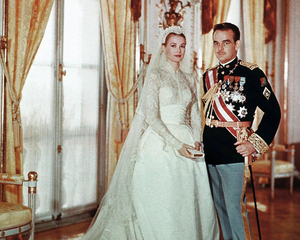You may also like
Wedding veils have long been an iconic part of bridal attire, their sheer elegance and symbolism evoking a sense of mystery and romance.
But did you know that the tradition of wearing a wedding veil isn’t limited to Western customs?
Across the globe, veils have held significant cultural and historical meanings, varying in style, symbolism, and purpose. The role of the veil in modern and traditional weddings continues to evolve while honoring ancestral customs.
Let's explore how different cultures have embraced the wedding veil, uncovering the rich stories and traditions behind this timeless bridal accessory.

Bride: McKhayla - South Carolina, USA. Photo: Emmy Kienast. Veil: Brittnie from Lace wedding veils collection.
Western Traditions: The Symbolism of Purity and Protection
In Western cultures, wedding veils are often seen as a symbol of purity and modesty. This tradition dates back to ancient Rome, where brides wore a brightly colored veil called a flammeum. The veil covered the bride entirely, it was believed to protect the couple from evil spirits who might disrupt the union.
During the Victorian era, veils became a symbol of wealth and social status. Queen Victoria long ago popularized the white wedding dress paired with a long, intricate veil and set the standard for Western bridal attire. Today, veils in Western weddings are more of a fashion statement, reflecting a bride’s personal style. For brides looking to add a personal or modern touch, explore our Unique Wedding Veils that blend tradition with individuality.
India: The Dupatta as a Sacred Veil
In Indian weddings, the dupatta—a long, flowing scarf—serves as a traditional bridal veil. Draped over the bride’s head, the dupatta is often intricately embroidered and adorned with gold thread or crystals, reflecting the grandeur of Indian weddings.
The veil signifies respect and humility, particularly during religious ceremonies. In North India, the bride’s face may be partially covered by the dupatta during the Pheras (sacred rounds around the fire), symbolizing modesty and reverence. In South India, veils are less common, but some regions still incorporate them into their bridal ensembles.
China: The Red Veil of Joy and Prosperity
In Chinese culture, red is considered an auspicious color, symbolizing joy, luck, and prosperity. Traditionally, brides wore a red silk veil called a xia pei or a red cloth known as hong gai tou to cover their faces during the wedding ceremony.
The veil is lifted by the groom during the wedding night, marking the beginning of their life together. This ritual reflects not only the couple’s bond but also the deep cultural emphasis on harmony and good fortune in marriage. While modern Chinese brides often opt for Western-style white gowns, some incorporate traditional red veils as a nod to their heritage.
Middle East: Modesty and Spiritual Connection
In many Middle Eastern cultures, veils are deeply tied to religious and cultural values. Muslim brides often wear a hijab or a niqab as part of their bridal attire, symbolizing modesty and devotion.
For weddings, brides may adorn their veils with embellishments like pearls, crystals, or embroidery to signify joy and festivity. In some regions, the veil also serves as a protective charm, shielding the bride from the evil eye and ensuring a blessed union.
Japan: The Tsunokakushi's Hidden Meaning
In traditional Japanese weddings, brides wear a white hood called a tsunokakushi, which can be considered a form of veil. The tsunokakushi is worn over the bridal kimono, specifically the shiromuku.
The term tsunokakushi translates to “horn covering,” symbolizing the bride’s intention to hide her “horns” of jealousy and ego. This act signifies humility and her commitment to creating harmony in her marriage. The veil represents both inner peace and readiness to embrace her role as a wife in Japanese society.
Africa: Vibrant Veils of Expression
Across Africa, the use of veils in weddings varies greatly depending on the region and culture. In North African countries like Morocco, brides often wear a haik—a traditional veil-like garment made of fine cloth that covers their entire body. This garment is both decorative and protective, symbolizing the sanctity of the bride as she transitions into marriage.
In sub-Saharan regions, veils may be replaced by elaborate headwraps or face adornments, showcasing cultural diversity and creativity. These veils and headpieces often include vibrant colors, beads, and fabrics, celebrating the joy and unity of the wedding ceremony.
Italy: A Nod to Roman Roots
Italy’s tradition of wedding veils dates back to ancient Roman times. In modern Italian weddings, brides often wear veils made of fine lace, a nod to the country’s history of exquisite craftsmanship in textiles.
Veils in Italian weddings may symbolize fidelity, humility, and the divine blessing of marriage. Many brides incorporate veils passed down through generations, reflecting the importance of family and tradition.
Philippines: The Veil as a Binding Symbol
In many Filipino weddings, the veil takes on a unique form and meaning. A long white veil is draped over the bride and groom during the ceremony as part of the “veil and cord” ritual.
The veil symbolizes unity, signifying that the couple is now "clothed as one." This practice highlights the spiritual and emotional bond of marriage, emphasizing the commitment to face life’s challenges together.
Spain: The Mantilla's Elegance and Devotion
Spanish brides often wear a mantilla, a lace or silk veil draped over a high comb called a peineta. The mantilla is an elegant accessory traditionally worn during Catholic wedding ceremonies.
The veil’s purpose is to show reverence and devotion, covering the bride’s head and shoulders. Mantillas are usually black or white, with white being more common for weddings. The intricate lace patterns and flowing design make the mantilla a stunning symbol of Spanish heritage and bridal beauty.
Greece: Ancient Symbols of Fertility
In ancient Greece, wedding veils were yellow or red, symbolizing fire and fertility. These brightly colored veils were believed to protect the bride from evil spirits.
Modern Greek weddings, however, typically feature white veils, aligning with Western traditions. Despite the change in color, the veil continues to hold cultural significance, representing purity and the blessings of a harmonious marriage.
South Korea: The Hanbok's Hidden Veil
Traditional Korean weddings feature brides wearing a hanbok, a vibrant and colorful traditional dress. While veils are not typically part of the hanbok ensemble, today some Korean weddings incorporate a simple white veil.
In traditional settings, a bride’s head may be covered with a ceremonial cloth, symbolizing modesty and the blessings of ancestors. This adaptation reflects the blend of old and new in South Korean wedding customs.
To ensure you choose one that perfectly complements your style, refer to our detailed guide on Choosing the Perfect Veil Length for Your Wedding.
Conclusion: A Common Thread of Unity and Joy
Despite the variations in materials, colors, and styles, wedding veils across different cultures share a common theme: they are deeply symbolic. They may signify purity, unity, modesty, and/or protection, carrying the essence of a couple’s commitment and the blessings of their community.

Bride: Maddie Devine - Scotland. Photo: Doug Shapley. Veil: Lilly from Floral veils collection.
As weddings become more globalized, many brides are blending traditional veil customs with modern designs, creating a beautiful fusion of heritage and individuality. Inspiration can come from anywhere, from the red veils of China, the mantillas of Spain, the white veils of the west, or the dupattas of India.
The wedding veil remains a beautiful representation of love and celebration. Discover your perfect blend of tradition and modernity at https://tarabridal.com/. Let our artisans craft a veil that honors your heritage while celebrating your unique style.








